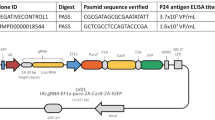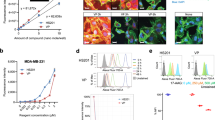Abstract
Adjuvant hyperthermia can improve treatment outcome for locally recurrent breast cancer (LRBC). Previously, we demonstrated that infection of human breast cancer cells with a recombinant adenovirus expressing β-galactosidase from the human hsp70b gene promoter (Ad.70b.βgal) results in 50- to 800-fold increases in reporter gene expression following heat treatment (30 minutes at 43°C). Here, we describe a heat-directed suicide gene therapy strategy based on an adenoviral vector (Ad.70b.CDTK) in which expression of the dual prodrug-activating E. coli cytosine deaminase/herpes simplex virus thymidine kinase (CDTK) fusion gene is under the control of the hsp70b promoter. Treatment of T47D and MCF-7 breast cancer cells with mild hyperthermia (43°C/30 minutes) and prodrugs (100 μg/ml 5-fluorocytosine and 10 μg/ml ganciclovir) following infection with Ad.70b.CDTK (10–100 PFU/cell) resulted in 30- to 60-fold decreases in clonogenic survival relative to control cultures treated with heat or prodrugs alone. Clonogenic survival declined even further (up to 240-fold) following heat treatment at 41.5°C for 120 minutes. A decreased clonogenic survival was accompanied by tumor cell apoptosis. These results demonstrate that this combined treatment strategy can be highly effective against heat- and radiation-resistant breast tumor cells and supports the continued development of heat-directed CDTK suicide gene therapy strategies for LRBC.
This is a preview of subscription content, access via your institution
Access options
Subscribe to this journal
Receive 12 print issues and online access
$259.00 per year
only $21.58 per issue
Buy this article
- Purchase on Springer Link
- Instant access to full article PDF
Prices may be subject to local taxes which are calculated during checkout




Similar content being viewed by others

References
Howe HL, Wingo PA, Thun MJ, et al. Annual report to the nation on the status of cancer (1973 through 1998), featuring cancers with recent increasing trends. J Natl Cancer Inst. 2001;93:824–842.
Clemons M, Danson S, Hamilton T, et al. Locoregionally recurrent breast cancer: incidence, risk factors and survival. Cancer Treat Rev. 2001;27:67–82.
van der Zee J, van der Holt B, Rietveld PJ, et al. Reirradiation combined with hyperthermia in recurrent breast cancer results in a worthwhile local palliation. Br J Cancer. 1999;79:483–490.
Clemons M, Hamilton T, Goss P . Does treatment at the time of locoregional failure of breast cancer alter prognosis? Cancer Treat Rev. 2001;27:83–97.
Vernon CC, Hand JW, Field SB, et al. Radiotherapy with or without hyperthermia in the treatment of superficial localized breast cancer: results from five randomized controlled trials. International Collaborative Hyperthermia Group [see comments]. Int J Radiat Oncol Biol Phys. 1996;35:731–744.
Brade AM, Ngo D, Szmitko P, et al. Heat-directed gene targeting of adenoviral vectors to tumor cells. Cancer Gene Ther. 2000;7:1566–1574.
Blackburn RV, Galoforo SS, Corry PM, et al. Adenoviral-mediated transfer of a heat-inducible double suicide gene into prostate carcinoma cells. Cancer Res. 1998;58:1358–1362.
Braiden V, Ohtsuru A, Kawashita Y, et al. Eradication of breast cancer xenografts by hyperthermic suicide gene therapy under the control of the heat shock protein promoter. Hum Gene Ther. 2000;11:2453–2463.
Gerner EW, Hersh EM, Pennington M, et al. Heat-inducible vectors for use in gene therapy. Int J Hyperthermia. 2000;16:171–181.
Huang Q, Hu JK, Lohr F, et al. Heat-induced gene expression as a novel targeted cancer gene therapy strategy. Cancer Res. 2000;60:3435–3439.
Vekris A, Maurange C, Moonen C, et al. Control of transgene expression using local hyperthermia in combination with a heat-sensitive promoter. J Gene Med. 2000;2:89–96.
Borrelli MJ, Schoenherr DM, Wong A, et al. Heat-activated transgene expression from adenovirus vectors infected into human prostate cancer cells. Cancer Res. 2001;61:1113–1121.
Lohr F, Hu K, Huang Q, et al. Enhancement of radiotherapy by hyperthermia-regulated gene therapy. Int J Radiat Oncol Biol Phys. 2000;48:1513–1518.
Kampinga HH, Brunsting JF, Stege GJ, et al. Thermal protein denaturation and protein aggregation in cells made thermotolerant by various chemicals: role of heat shock proteins. Exp Cell Res. 1995;219:536–546.
Henle KJ, Jethmalani SM, Li L, et al. Protein glycosylation in a heat-resistant rat fibroblast cell model expressing human HSP70. Biochem Biophys Res Commun. 1997;232:26–32.
Kim JH, Kolozsvary A, Rogulski K, et al. Selective radiosensitization of 9L glioma in the brain transduced with double suicide fusion gene [see comments]. Cancer J Sci Am. 1998;4:364–369.
Rogulski KR, Zhang K, Kolozsvary A, et al. Pronounced antitumor effects and tumor radiosensitization of double suicide gene therapy. Clin Cancer Res. 1997;3:2081–2088.
Xie Y, Gilbert JD, Kim JH, et al. Efficacy of adenovirus-mediated CD/5-FC and HSV-1 thymidine kinase/ganciclovir suicide gene therapies concomitant with p53 gene therapy. Clin Cancer Res. 1999;5:4224–4232.
Graham FL, Prevec L . Adenovirus-based expression vectors and recombinant vaccines [review]. Biotechnology. 1992;20:363–390.
Li JH, Lax SA, Kim J, et al. The effects of combining ionizing radiation and adenoviral p53 therapy in nasopharyngeal carcinoma. Int J Radiat Oncol Biol Phys. 1999;43:607–616.
Li JH, Li P, Klamut H, et al. Cytotoxic effects of Ad5CMV-p53 expression in two human nasopharyngeal carcinoma cell lines. Clin Cancer Res. 1997;3:507–514.
Fishman JA, Doran MT, Volpicelli SA, et al. Dosing of intravenous ganciclovir for the prophylaxis and treatment of cytomegalovirus infection in solid organ transplant recipients. Transplantation. 2000;69:389–394.
Hoganson DK, Batra RK, Olsen JC, et al. Comparison of the effects of three different toxin genes and their levels of expression on cell growth and bystander effect in lung adenocarcinoma. Cancer Res. 1996;56:1315–1323.
Sherar M, Liu FF, Pintilie M, et al. Relationship between thermal dose and outcome in thermoradiotherapy treatments for superficial recurrences of breast cancer: data from a phase III trial. Int J Radiat Oncol Biol Phys. 1997;39:371–380.
Li PX, Ngo D, Brade AM, et al. Differential chemosensitivity of breast cancer cells to ganciclovir treatment following adenovirus-mediated herpes simplex virus thymidine kinase gene transfer. Cancer Gene Ther. 1999;6:179–190.
Falk MH, Issels RD . Hyperthermia in oncology. Int J Hyperthermia. 2001;17:1–18.
Shioura H, Hayashi S, Matsumoto H, et al. The effects of combined treatments with low hyperthermia and bleomycin on survivals of murine L cells. J Exp Clin Cancer Res. 1997;16:147–152.
Ohtsubo T, Igawa H, Saito T, et al. Enhancement of cell killing by induction of apoptosis after treatment with mild hyperthermia at 42 degrees C and cisplatin. Radiat Res. 2001;156:103–109.
Hudis CA, Norton L . Adjuvant drug therapy for operable breast cancer. Semin Oncol. 1996;23:475–493.
Janicke RU, Engels IH, Dunkern T, et al. Ionizing radiation but not anticancer drugs causes cell cycle arrest and failure to activate the mitochondrial death pathway in MCF-7 breast carcinoma cells. Oncogene. 2001;20:5043–5053.
Ma N, Jin J, Lu F, et al. The role of protein kinase B (PKB) in modulating heat sensitivity in a human breast cancer cell line. Int J Radiat Oncol Biol Phys. 2001;50:1041–1050.
Matsumoto H, Takahashi A, Wang X, et al. Transfection of p53-knockout mouse fibroblasts with wild-type p53 increases the thermosensitivity and stimulates apoptosis induced by heat stress. Int J Radiat Oncol Biol Phys. 1997;38:1089–1095.
van Bree C, van der Maat B, Ceha HM, et al. Inactivation of p53 and of pRb protects human colorectal carcinoma cells against hyperthermia-induced cytotoxicity and apoptosis. J Cancer Res Clin Oncol. 1999;125:549–555.
Nieves-Neira W, Pommier Y . Apoptotic response to camptothecin and 7-hydroxystaurosporine (UCN-01) in the 8 human breast cancer cell lines of the NCI Anticancer Drug Screen: multifactorial relationships with topoisomerase I, protein kinase C, Bcl-2, p53, MDM-2 and caspase pathways. Int J Cancer. 1999;82:396–404.
Lee YJ, Galoforo SS, Battle P, et al. Replicating adenoviral vector-mediated transfer of a heat-inducible double suicide gene for gene therapy. Cancer Gene Ther. 2001;8:397–404.
Lax SA, Chia MC, Busson P, et al. Adenovirus-p53 gene therapy in human nasopharyngeal carcinoma xenografts. Radiother Oncol. 2001;61:309–312.
Li JH, Chia M, Shi W, et al. Tumor-targeted gene therapy for nasopharyngeal carcinoma. Cancer Res. 2002;62:171–178.
Bischoff JR, Kirn DH, Williams A, et al. An adenovirus mutant that replicates selectively in p53-deficient human tumor cells. Science. 1996;274:373–376.
Li Y, McCadden J, Ferrer F, et al. Prostate-specific expression of the diphtheria toxin A chain (DT-A): studies of inducibility and specificity of expression of prostate-specific antigen promoter-driven DT-A adenoviral-mediated gene transfer. Cancer Res. 2002;62:2576–2582.
Chong H, Ruchatz A, Clackson T, et al. A system for small-molecule control of conditionally replication-competent adenoviral vectors. Mol Ther. 2002;5:195–203.
Wildner O, Morris JC, Vahanian NN, et al. Adenoviral vectors capable of replication improve the efficacy of HSVtk/GCV suicide gene therapy of cancer. Gene Therapy. 1999;6:57–62.
Rogulski KR, Wing MS, Paielli DL, et al. Double suicide gene therapy augments the antitumor activity of a replication-competent lytic adenovirus through enhanced cytotoxicity and radiosensitization. Hum Gene Ther. 2000;11:67–76.
Hernandez-Alcoceba R, Pihalja M, Wicha MS, et al. A novel, conditionally replicative adenovirus for the treatment of breast cancer that allows controlled replication of E1a-deleted adenoviral vectors. Hum Gene Ther. 2000;11:2009–2024.
Kurihara T, Brough DE, Kovesdi I, et al. Selectivity of a replication-competent adenovirus for human breast carcinoma cells expressing the MUC1 antigen. J Clin Invest. 2000;106:763–771.
Acknowledgements
We thank our colleagues, in particular M Rauth and M Sherar, for stimulating discussions. This work was supported in part by grants to HJK from the Canadian Breast Cancer Foundation and the Foundation for Gene and Cell Therapy, and to FFL and HJK from the Canadian Institutes of Health Research (CIHR). AMB is a recipient of the Jessie Davidson Medical Research Council of Canada Fellowship, and thanks Drs B Cummings and P Catton and the DRO for their continued support.
Author information
Authors and Affiliations
Corresponding author
Rights and permissions
About this article
Cite this article
Brade, A., Szmitko, P., Ngo, D. et al. Heat-directed suicide gene therapy for breast cancer. Cancer Gene Ther 10, 294–301 (2003). https://doi.org/10.1038/sj.cgt.7700570
Received:
Published:
Issue Date:
DOI: https://doi.org/10.1038/sj.cgt.7700570
Keywords
This article is cited by
-
Hyperthermia: an effective strategy to induce apoptosis in cancer cells
Apoptosis (2015)
-
Dual-therapeutic reporter genes fusion for enhanced cancer gene therapy and imaging
Gene Therapy (2013)
-
Retrovirus-mediated tk gene therapy of implanted human breast cancer in nude mice under the regulation of Tet-On
Cancer Gene Therapy (2006)


